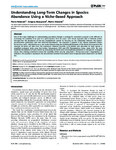Understanding long-term changes in species abundance using a niche-based approach.
| dc.contributor.author | Helaouët, P | en |
| dc.contributor.author | Beaugrand, G | en |
| dc.contributor.author | Edwards, M | en |
| dc.date.accessioned | 2019-11-27T12:18:42Z | |
| dc.date.available | 2019-11-27T12:18:42Z | |
| dc.date.issued | 2013 | en |
| dc.identifier.uri | http://hdl.handle.net/10026.1/15196 | |
| dc.description.abstract |
One of the major challenges to understanding population changes in ecology for assessment purposes is the difficulty in evaluating the suitability of an area for a given species. Here we used a new simple approach able to faithfully predict through time the abundance of two key zooplanktonic species by focusing on the relationship between the species' environmental preferences and their observed abundances. The approach is applied to the marine copepods Calanus finmarchicus and C. helgolandicus as a case study characterising the multidecadal dynamics of the North Sea ecosystem. We removed all North Sea data from the Continuous Plankton Recorder (CPR) dataset and described for both species a simplified ecological niche using Sea Surface Temperature (SST) and CPR Phytoplankton Colour Index (PCI). We then modelled the dynamics of each species by associating the North Sea's environmental parameters to the species' ecological niches, thus creating a method to assess the suitability of this area. By using both C. finmarchicus and C. helgolandicus as indicators, the procedure reproduces the documented switches from cold to warm temperate states observed in the North Sea. | en |
| dc.format.extent | e79186 - ? | en |
| dc.language | eng | en |
| dc.language.iso | eng | en |
| dc.subject | Animals | en |
| dc.subject | Ecosystem | en |
| dc.subject | Environment | en |
| dc.subject | Models, Statistical | en |
| dc.subject | North Sea | en |
| dc.subject | Phytoplankton | en |
| dc.subject | Population Density | en |
| dc.subject | Population Dynamics | en |
| dc.subject | Time Factors | en |
| dc.subject | Zooplankton | en |
| dc.title | Understanding long-term changes in species abundance using a niche-based approach. | en |
| dc.type | Journal Article | |
| plymouth.author-url | https://www.ncbi.nlm.nih.gov/pubmed/24265757 | en |
| plymouth.issue | 11 | en |
| plymouth.volume | 8 | en |
| plymouth.publication-status | Published online | en |
| plymouth.journal | PLoS One | en |
| dc.identifier.doi | 10.1371/journal.pone.0079186 | en |
| plymouth.organisational-group | /Plymouth | |
| plymouth.organisational-group | /Plymouth/Faculty of Science and Engineering | |
| plymouth.organisational-group | /Plymouth/REF 2021 Researchers by UoA | |
| plymouth.organisational-group | /Plymouth/REF 2021 Researchers by UoA/UoA07 Earth Systems and Environmental Sciences | |
| dc.publisher.place | United States | en |
| dcterms.dateAccepted | 2013-09-24 | en |
| dc.identifier.eissn | 1932-6203 | en |
| dc.rights.embargoperiod | Not known | en |
| rioxxterms.versionofrecord | 10.1371/journal.pone.0079186 | en |
| rioxxterms.licenseref.uri | http://www.rioxx.net/licenses/all-rights-reserved | en |
| rioxxterms.licenseref.startdate | 2013 | en |
| rioxxterms.type | Journal Article/Review | en |


